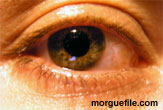Eyelids Alter Shape of the Eye

The pressure of the eyelid on the eyeball could cause one of the most common vision problems, new research shows.
The work builds on previous research showing that heavy reading can change the shape of the eye during the day, temporarily degrading eyesight.
Imperfections in the shape of the cornea, a transparent shield that protects and covers the front of the eyeball, often causes corneal astigmatism.? The condition, which affects somewhere between 33 and 60 percent of all people, can lead to distorted vision.
The study of 100 normal-sighted young subjects showed that the shape of the eyelid opening at different angles of gaze affected the shape of the cornea, says Scott Read of Queensland University of Technology, in Brisbane, Australia.
"It appears eyelids do play a part in determining the shape of the cornea," Read said. "One explanation is that pressure from the eyelids is involved in the cause of corneal astigmatism."
The results, announced last week, were published in the journal Optometry and Vision Science.
It is still unproven that eyelid pressure definitely causes corneal astigmatism, Read told LiveScience.
Sign up for the Live Science daily newsletter now
Get the world’s most fascinating discoveries delivered straight to your inbox.
"An important next step is for us to develop an accurate and precise means of measuring the amount of pressure that the eyelids do exert on the cornea," he said. Then scientists could link those measurements with the development of astigmatism.
Astigmatism and corneal shape change a lot in young children and older people, so Read also plans to study the peepers and lids of those populations to learn more.
Astigmatism takes a few different forms. One way to think of one form of it is to envision light coming into the eye along two perpendicular axes. With astigmatism, the light along one axis is more in focus than the light along the other. In other cases, the light fails to line up with the light-receiving axes in the eye.
Heavy readers, take note: Earlier research by Read and his colleagues shows that downcast eyelids degrade your vision, pressing against the cornea and worsening eyesight as the day wears on.
People who read or do close work tend to maintain a downward gaze for a long time, such that the upper eyelid exerts pressure on the cornea and actually changes the shape of the eyes throughout the day. ?
The study found that the shape of the cornea changed significantly throughout the day, with the eyelid pressure forming horizontal bands of distortion on the cornea where the eyelid was sitting. The cornea bounced back by morning.
"As these changes appear to be related to forces from the eyelids themselves and were more marked in people who spent a lot of time reading in downward gaze, it is certainly one reason why people's vision may be slightly worse at the end of the day or after doing a lot of close work," Read said.
"It suggests," he said, "that people should take a short break from reading or close work at least every hour."
Robin Lloyd was a senior editor at Space.com and Live Science from 2007 to 2009. She holds a B.A. degree in sociology from Smith College and a Ph.D. and M.A. degree in sociology from the University of California at Santa Barbara. She is currently a freelance science writer based in New York City and a contributing editor at Scientific American, as well as an adjunct professor at New York University's Science, Health and Environmental Reporting Program.










